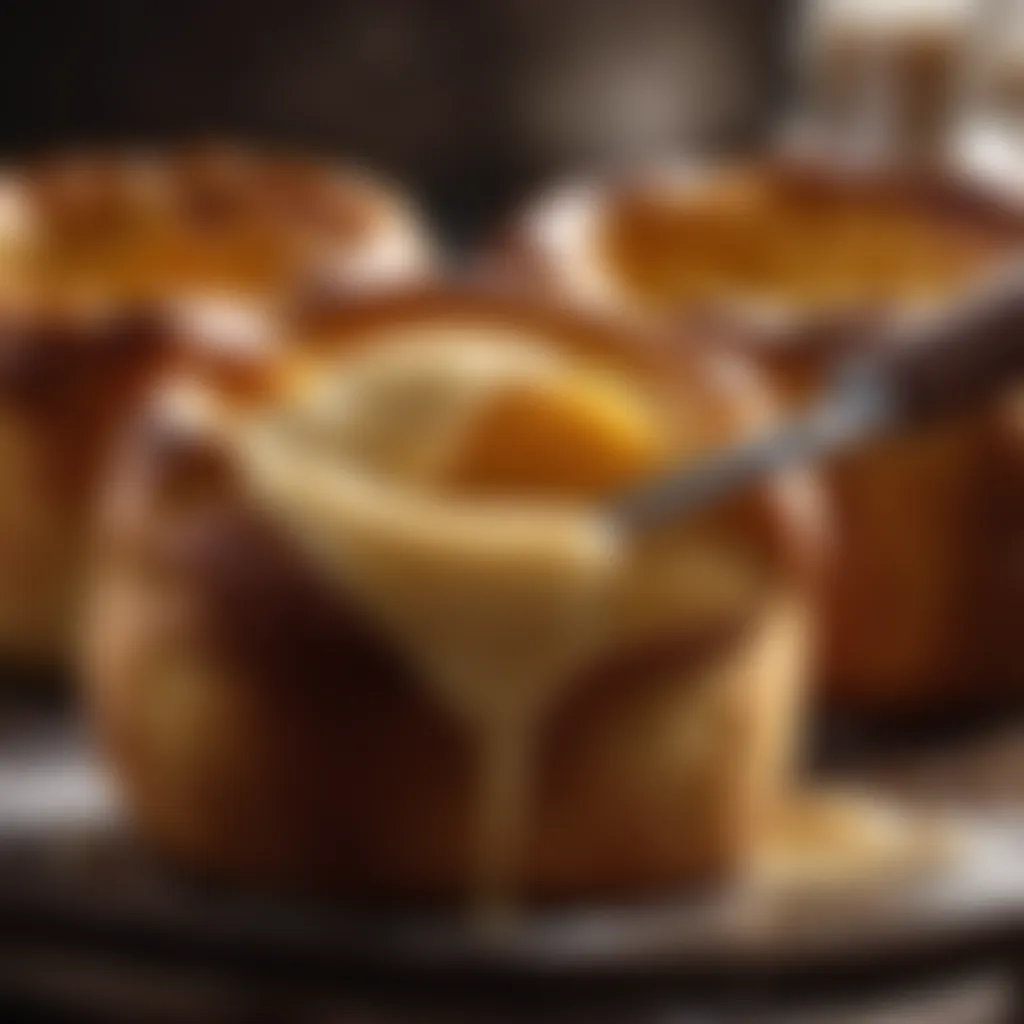Crafting a Distinctive Lamb Aqdah Recipe

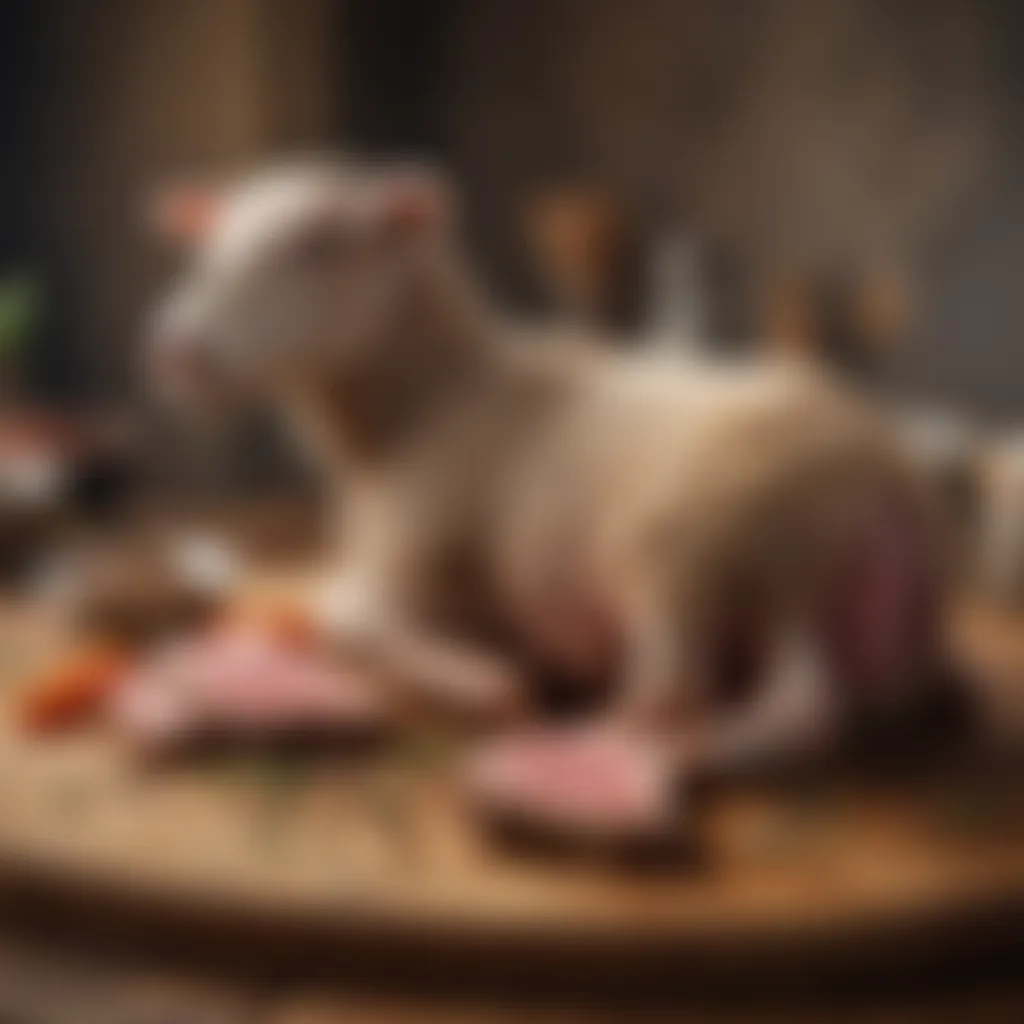
Intro
Crafting a flavorful lamb aqdah dish is not just about preparing a meal; it's about weaving together rich history and cultural significance. Originating from various traditions, this dish encapsulates the warmth of home-cooked food while also symbolizing celebration and togetherness. As you delve into this culinary journey, the blend of spices, careful selection of ingredients, and the methodical preparation will become a canvas for your creativity. Let’s embark on this flavorful adventure, one step at a time.
Ingredients:
When diving into the world of lamb aqdah, it’s crucial to start with the right ingredients. Here’s what you’ll need:
- Lamb shoulder: 1.5 kg, cut into cubes
- Onions: 2 medium, finely chopped
- Garlic: 4 cloves, minced
- Ginger: 1 tablespoon, minced
- Tomatoes: 2 medium, diced
- Carrots: 2, sliced
- Potatoes: 3 medium, cubed
- Green chilies: 2, slit
- Yogurt: 200 grams
- Cooking oil: 4 tablespoons
- Salt: to taste
- Turmeric powder: 1 teaspoon
- Coriander powder: 1 tablespoon
- Cumin powder: 1 teaspoon
- Black pepper: 1 teaspoon
- Cinnamon stick: 1 inch
- Cardamom pods: 4
- Bay leaves: 2
- Fresh coriander: for garnish
Preparation Steps:
Start by prepping your ingredients. This approach not only streamlines the cooking process, but it also allows for a more enjoyable cooking experience. Follow these detailed steps:
- Marinate the Lamb: In a bowl, combine the lamb cubes, yogurt, salt, turmeric powder, and a pinch of black pepper. Mix well and let it marinate for at least one hour.
- Chop the Veggies: While the lamb marinates, finely chop the onions, mince the garlic and ginger, dice the tomatoes, slice the carrots, and cube the potatoes. Keeping everything neatly chopped makes the cooking flow smoother.
Technical Aspects:
Pay attention to these technical details to ensure success with your lamb aqdah:
- Temperature Settings: Aim for medium heat during the initial steps.
- Timing Specifics: 1 hour for marinating, followed by another 1 to 1.5 hours for cooking.
- Critical Techniques: Browning the meat is crucial before adding other ingredients, as it develops rich flavors.
Cooking Process:
Let’s follow a sequential process to bring everything together:
- Heat Oil: Start by heating the cooking oil in a large pot over medium heat. Once hot, add the chopped onions, and sauté until they turn golden brown.
- Add Aromatics: Next, incorporate garlic and ginger, stirring for about a minute until fragrant.
- Introduce Lamb: Add the marinated lamb to the pot, allowing it to brown for about 10-15 minutes. This step is key to locking in flavors.
- Combine Veggies: Stir in the diced tomatoes, sliced carrots, and cubed potatoes. Mix well.
- Spices and Simmer: Toss in the slit green chilies, cinnamon stick, cardamom pods, bay leaves, and your remaining spices. Pour in enough water to cover the ingredients and bring everything to a boil.
- Slow Cook: Reduce the heat to low, cover the pot, and let the dish simmer for approximately 1 hour, stirring occasionally. The idea is to allow flavors to meld beautifully.
- Garnish and Serve: Once cooked, adjust seasoning, and garnish with fresh coriander just before serving.
Tip: Taste before serving; adjusting the seasoning can elevate the dish significantly.
Troubleshooting Tips:
Even the best-laid plans can go awry. Here are solutions for common missteps:
- If it’s too salty: Add a sliced potato during cooking to absorb some of the salt.
- If the meat is tough: You may need to adjust cooking time and allow it to simmer longer.
- If it lacks flavor: A dash more of spices can help, along with a touch more salt or even a bit of acid like lemon juice.
Embedding love and tradition into your lamb aqdah not only elevates the dish but also creates a space for memories to be made.
Next, we’ll explore the cultural significance this dish holds across various regions.
Overview of Lamb Aqdah
Lamb Aqdah represents not merely a dish but a tapestry of flavors and traditions woven over countless generations. This overview encapsulates its significance in culinary practices, providing insights and context that elevate the recipe to a realm where food becomes more than sustenance; it transforms into an experience. As we embark on this exploration, we will look closely at its definition, history, and the cultural nuances that affect its preparation and enjoyment.
Definition and Origin
Lamb Aqdah, in many ways, is a reflection of tradition and creativity. The term itself is derived from the Arabic word "aqd," meaning to tie or bind. This concept resonates with the way ingredients are intricately blended, echoing the connection between the chef and the cultural history embedded in the dish. Originating from regions where lamb is a staple—like the Middle East and parts of North Africa—this dish marries the tenderness of lamb with a cornucopia of spices. Origin stories often trace back to rural households, where culinary practices were developed to maximize flavor while utilizing local ingredients.
Cultural Importance
The cultural importance of Lamb Aqdah cannot be overstated. In many societies, a meal is more than just food; it embodies familial ties, communal bonds, and a sense of identity. In gatherings, Lamb Aqdah takes center stage, symbolizing hospitality and offering. It serves as a vehicle for storytelling, as families often pass down secret recipes through generations, allowing the essence of the dish to evolve while still holding onto its roots. From festivals to daily meals, the preparation and enjoyment of Lamb Aqdah create a communal spirit, thus deepening interpersonal connections.
"In every bite of Lamb Aqdah, one can taste the stories of the past, the love of family, and the spirit of celebration."
Understanding this dish is pivotal for anyone looking to truly appreciate its flavors and the culture behind it. It involves not just ingredients but emotions, memories, and a rich history that continues to thrive in modern kitchens today. As we proceed into exploring its key ingredients and preparation techniques, each step will reveal how the intricacies of Lamb Aqdah carry forward the legacy of many communities.
Understanding Key Ingredients
When it comes to crafting a memorable lamb aqdah, understanding the key ingredients isn't just important; it's essential. These components lay the groundwork for flavor and texture, inviting culinary enthusiasts into a world where every choice counts.
Choosing Quality Lamb
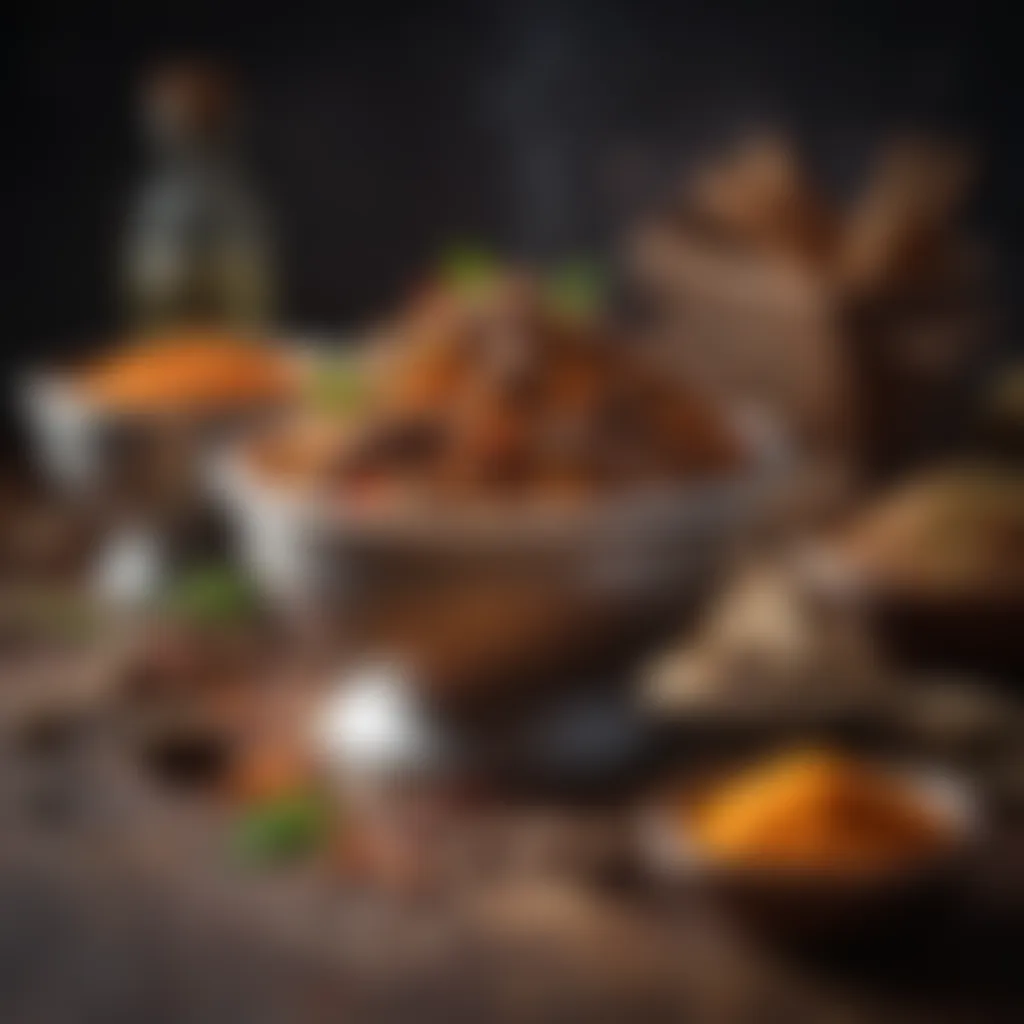
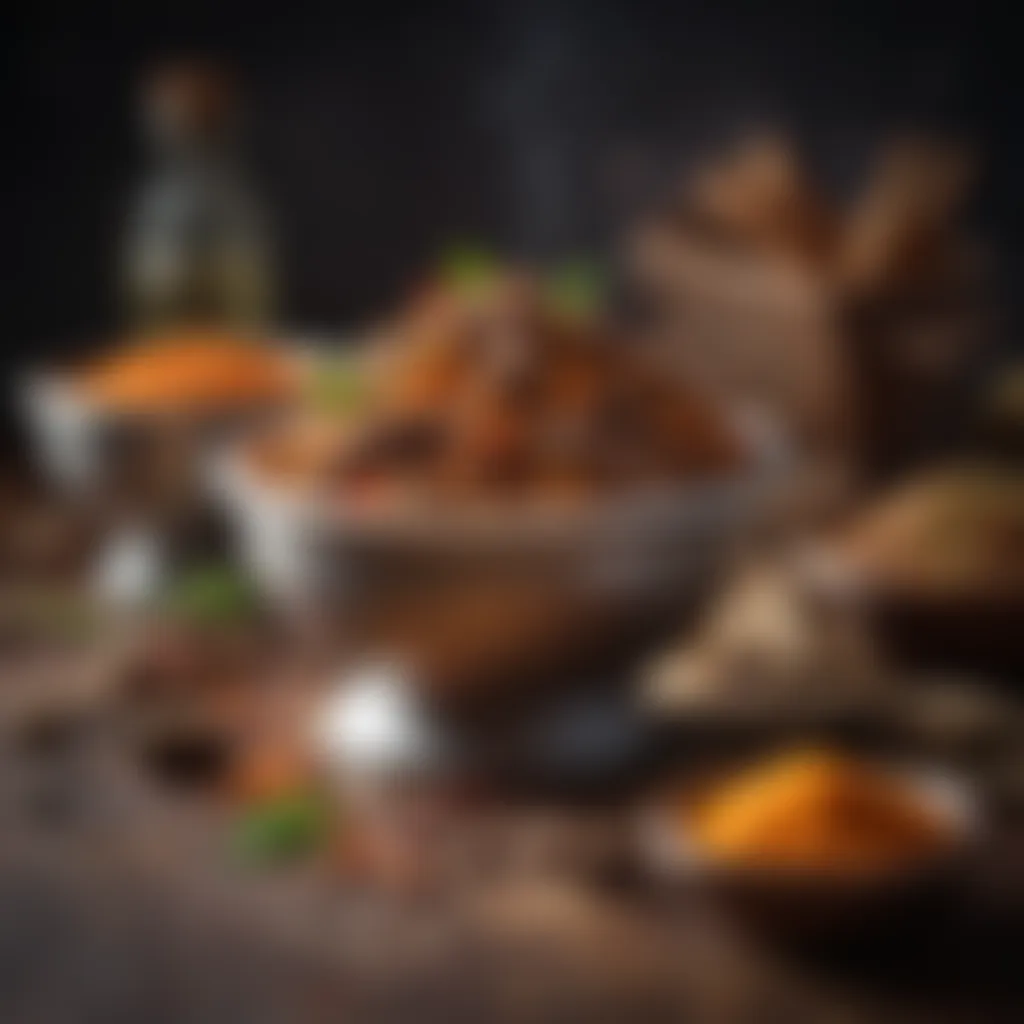
The foundation of any lamb dish starts with the lamb itself. You want to select lean cuts that are also succulent, so find shoulder or leg cuts. They ain’t just tasty; they’re versatile too! When shopping, check for a rich color and smooth fat. This ensures you’re getting meat that’s not only fresh but flavorful. If you can, speaking with a local butcher can provide insight into the best sources for your lamb. Sometimes, buying in bulk or directly from farms yields a better-quality product.
You should also be mindful of where the lamb comes from. Raised on pasture, the best lambs typically enjoy a varied diet, affecting the final flavor. When you're at a market, don’t hesitate to ask questions about the origins of the meat. Knowledge is key when it comes to choosing quality lamb.
Spice Profiles in Lamb Aqdah
Once you’ve got the lamb sorted, it's time to dive into the spices. These little flavor bombs transform an ordinary dish into something extraordinary. Start by considering traditional spices like cumin, coriander, and cardamom. This trio not only adds warmth but layers depth, too.
Many chefs enjoy experimenting by adding more personal favorite spices. For instance, a hint of cinnamon can introduce a warming sensation that dances in the background. Don't be shy about playing around! Each culture has its unique spin on spices, so think about the flavor journey you want to take your eaters on. Whether it's earthy, tangy, or even a bit sweet, the spice profile can set the tone for your lamb aqdah.
"The secret to great lamb aqdah is not just in the lamb but in the harmonious blend of spices that complement it!"
Essential Herbs and Vegetables
Let’s not forget about herbs and veggies! They add not just flavor but also vibrant color and health benefits. Fresh herbs such as parsley, mint, or cilantro can brighten your dish, cutting through the richness of the lamb. Consider adding these at the final stages of cooking or even as a garnish. This fresh touch can turn a hearty meal into a feast for the senses.
Then there are vegetables. Onions, garlic, and tomatoes are staple ingredients that build a solid base. Roasting them allows the natural sweetness to come through, enhancing the overall profile of the dish. And if you want to take it a step further, consider incorporating seasonal vegetables that can add texture and flair—like bell peppers or roasted carrots.
In summary, understanding key ingredients in lamb aqdah isn't just about following a recipe; it's about appreciating the individual components' role in the culinary masterpiece you are creating. Quality lamb, a thoughtfully chosen spice profile, and fresh herbs and vegetables all come together to create something truly delectable.
Preparation Techniques
When it comes to creating a flavorful lamb aqdah, preparation techniques play a pivotal role. This section is not just a checklist of what to do; it is about understanding the ways these methods contribute to the overall dish. Proper preparation can elevate the quality of the dish, ensuring that every bite is full of rich flavors. Whether you’re an experienced cook or a novice in the kitchen, acknowledging these techniques will distinctly influence the outcome of your lamb aqdah.
Marination Process
Marination is often the unsung hero of culinary success, especially with lamb. It involves soaking the meat in a blend of spices, herbs, and sometimes acidic agents like yogurt or lemon juice. This process does wonders beyond just enhancing flavors; it can also tenderize the meat. For lamb, a longer marination often translates to deeper flavor penetration. Here’s how it unfolds:
- Choose your marinade wisely: Using ingredients like garlic, cumin, and coriander can create a symphony of flavors that accompany lamb wonderfully.
- Time is of the essence: Aim for a minimum of two hours, but overnight is preferable if your schedule allows.
- Temperature consideration: Always marinate lamb in the refrigerator to keep it safe from bacteria.
By allowing the lamb to absorb these flavors, you transform the meat into something truly extraordinary, ready to stand proud in your dish.
Cooking Methods
Once marinated, the next step is choosing a suitable cooking method. Each method offers unique qualities that can accentuate the taste of lamb in different ways.
Roasting
Roasting lamb is a classic technique that shines when you want to achieve a tender, evenly-cooked piece of meat. It’s about slow exposure to heat, which allows the fat to render beautifully and keeps the meat moist.
- Key Characteristic: Slow cooking ensures that flavors meld and the outside gets that lovely caramelization.
- Benefit: Often regarded as a popular choice for gatherings—nothing beats the sight and aroma of a roast coming out of the oven.
- Unique Feature: Roasting allows for even heat distribution, ensuring the meat’s internal temperature rises gradually.
- Advantages: It’s hands-off once it’s in the oven; you can focus on the sides and presentation without much fuss.
- Disadvantages: Requires patience; roasting lamb can take time, and overcooking can lead to dryness.
Grilling
Grilling introduces an outdoor, rustic aspect to the cooking process. The char from the grill not only adds flavor but also brings an appealing texture to the lamb.
- Key Characteristic: Flames kiss the meat, creating a distinctive smoky flavor—almost a rite of passage for good meals.
- Benefit: Perfect for social occasions; it infuses a casual atmosphere while providing tasty results.
- Unique Feature: Direct heat caramelizes sugars on the surface rapidly, producing a crusty exterior.
- Advantages: Fast and gives an instant flavor boost; great for those last-minute meals.
- Disadvantages: Requires attention; it can cook quickly and may become tough if left unattended.
Sautéing
Sautéing is a somewhat quicker method, relying on a small amount of hot fat to cook the meat. It’s ideal for smaller cuts of lamb, and when done right, it can be exceptionally flavorful.
- Key Characteristic: This method allows for quick cooking, usually resulting in a nice sear while keeping the inside succulent.
- Benefit: It’s versatile and works well with additional ingredients like vegetables, making it a complete meal in one pan.
- Unique Feature: Sautéing gives you chance to deglaze the pan at the end, capturing all those flavors stuck to the bottom.
- Advantages: Fast cooking time; perfect for weeknight dinners or spontaneous guests.
- Disadvantages: It can require more attention than roasting; timing and heat control are crucial to avoid overcooking.
Embracing these preparation methods not only enhances the flavor but helps in gaining the confidence needed in the kitchen, allowing everyone to appreciate the artistry behind lamb aqdah.
Flavor Development Strategies
Flavor development is the backbone of any successful lamb aqdah dish. It’s not just about throwing ingredients together; it’s about understanding how flavors interact, complement, and enhance one another. Each element plays its part in creating a harmonious dish that speaks to the senses. Mastering flavor development can elevate a simple recipe into something extraordinary. This section delves into vital strategies that can turn a basic lamb aqdah into a culinary masterpiece.
Balancing Flavors
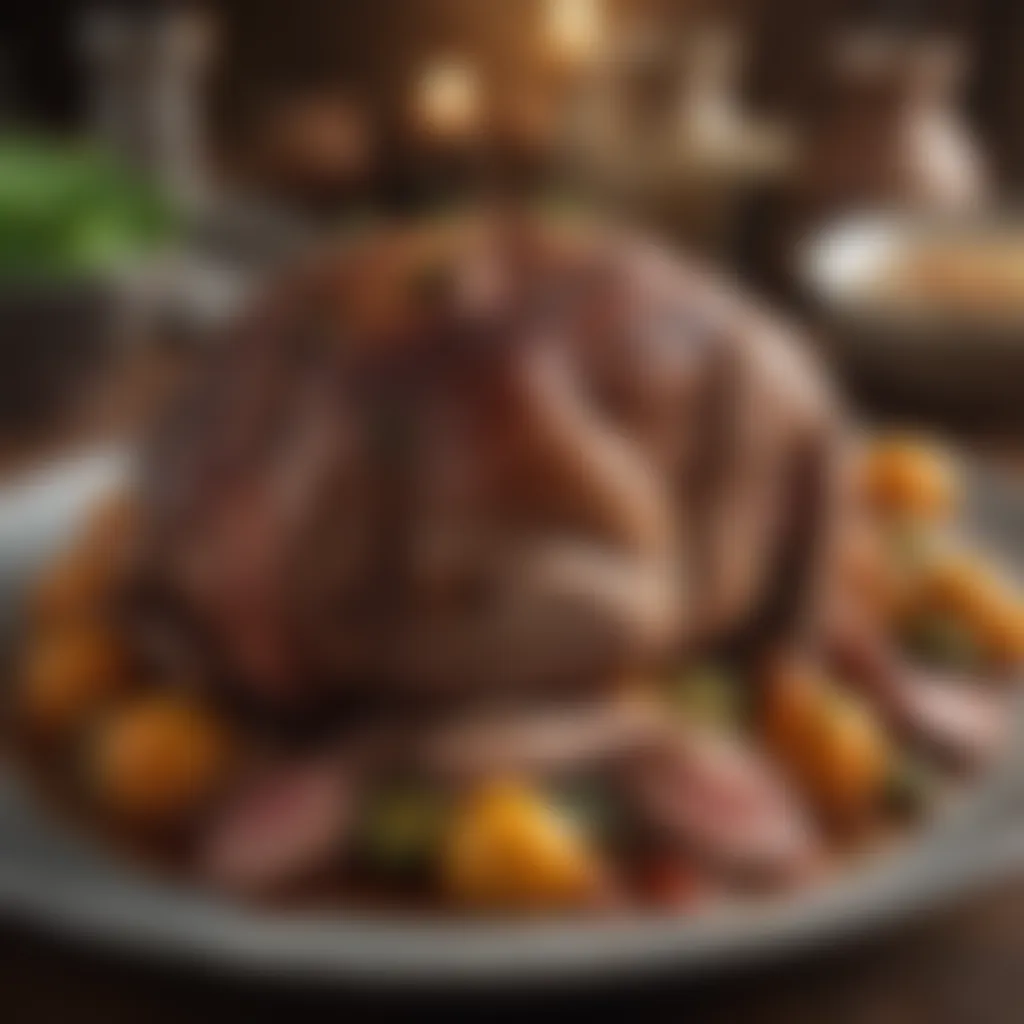
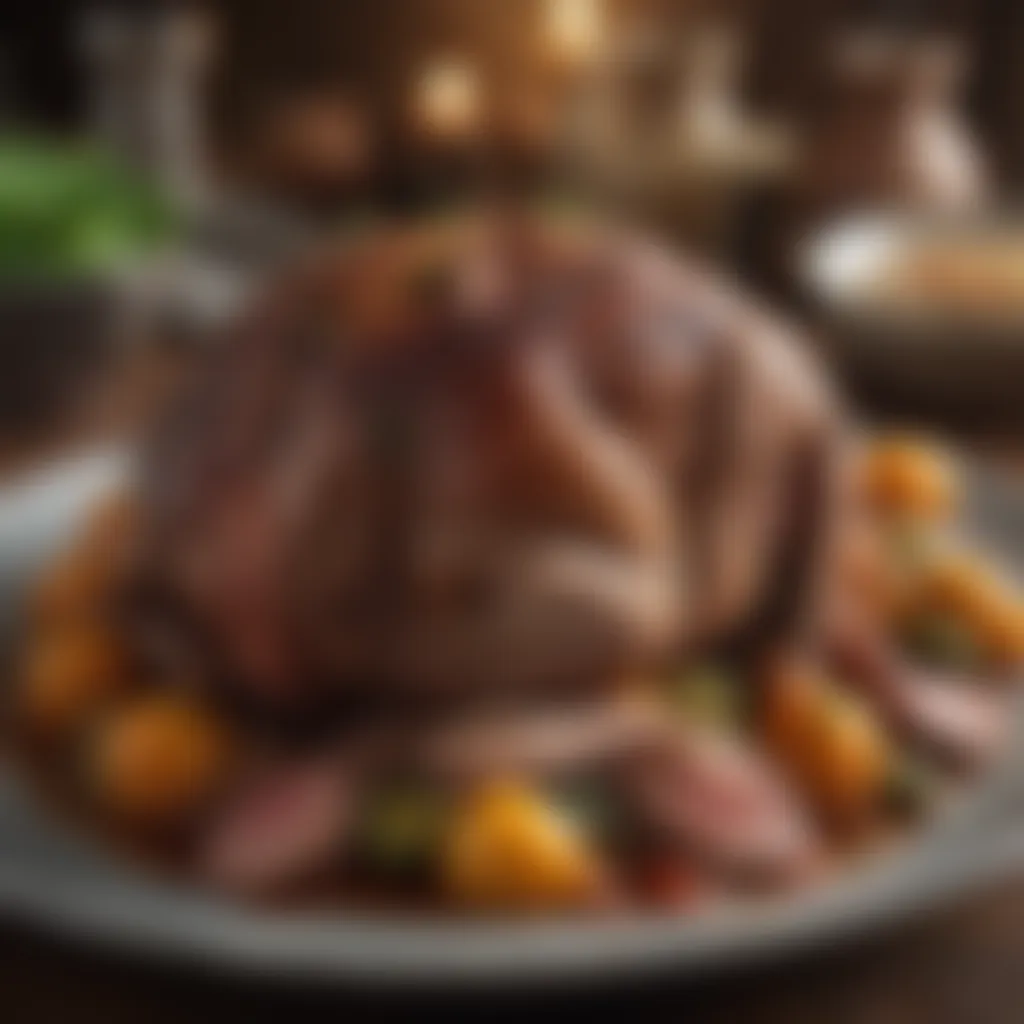
In the world of cooking, balancing flavors is akin to being a conductor of an orchestra. Each flavor—be it sweet, salty, sour, or bitter—has its unique timbre. For lamb aqdah, the goal is to find a sweetness that pairs with the rich savoriness of the lamb while avoiding clashes. To achieve balance:
- Salt: The unsung hero of any dish, salt accentuates flavors. Use it wisely during the cooking process and season dishes gradually. Too much will overpower, too little will leave the dish flat.
- Acidity: Incorporating a splash of acidity, such as lemon juice or vinegar, can lift flavors and bring a brightness that cuts through the richness of the lamb. This adds depth that is often overlooked.
- Herbs and Spices: Herbs like mint or cilantro can introduce freshness, while spices such as cumin and coriander give warmth. Mix and match to find the right balance that complements your dish without overpowering it.
- Sweetness: A touch of sweetness, perhaps from dried fruits or honey, can create an inviting contrast to the meat's savory notes. Just a pinch can go a long way.
The art of balancing flavors is an intuitive process. It requires tasting and adjusting along the way, much like altering a painting's hues until it achieves perfection.
Incorporating Depth with Sauces
Sauces are not merely additions; they are a critical component that can transform a dish. A well-crafted sauce can provide layers of flavor that elevate lamb aqdah to new heights. Consider these elements when creating your sauce:
- Base Ingredients: Start with a solid foundation, like stock or broth, which can add a rich dimension. A good quality lamb stock made from bones will enhance the umami undertones of the dish.
- Cooking Technique: Searing and developing a fond—those brown bits left in the pan—add a depth of flavor that can’t be replicated. Deglazing with wine or broth can lift those bits, infusing the sauce with complexity.
- Aromatics: Ingredients like garlic, shallots, and tomatoes can bring a bouquet of flavors. Cooking these slow and low helps to meld them into a unified sauce rather than delivering disjointed bursts.
- Finishing Touches: Adding fresh herbs at the end of cooking keeps their brightness. You could also intensify flavors with a pat of butter or a drizzle of high-quality olive oil for smoothness.
As you layer these components, remember that the key is not to distract from the lamb but to augment it. A deftly made sauce can create a dialogue between the meat and flavors, resulting in a well-rounded experience.
"A good dish is not just about the meat. It’s about the story it tells through its flavors, layer by layer."
Regional Variations
Regional variations in lamb aqdah exemplify how diverse culinary traditions and local ingredients shape this dish. In different cultures, lamb aqdah is more than just a meal; it symbolizes heritage and community. By observing these variations, one can gain insights into the history and flavors that drive each rendition of this beloved dish.
Several factors contribute to these regional interpretations. Local spices, cooking methods, and even cultural practices inform how lamb is prepared and enjoyed. It's exciting to note that what may be a staple in one area could be perceived entirely differently in another. For instance, some cultures might emphasize a milder flavor profile while others could lean towards bold, fiery spices. Therefore, understanding these variations not only enriches our cooking experience but also fosters a respect for the different tastes and practices entrenched in these culinary traditions.
Middle Eastern Influences
The Middle Eastern take on lamb aqdah is particularly vibrant, infused with a variety of spices and cooking techniques. Common spices include cumin, coriander, and sumac, which work together to create a complex flavor profile. Not to mention the influence of local herbs like parsley and mint, which often have a starring role in both the preparation and as garnishes.
Traditionally, Middle Eastern chefs may opt for slow-cooking methods such as braising or stewing, allowing the lamb to absorb the rich flavors of the spice mix. The result is tender, fall-off-the-bone meat that is steeped in aromatic seasoning. Additionally, serving lamb aqdah with side dishes such as tabbouleh or hummus further complements the hearty flavor of the dish, enhancing the overall dining experience.
As a point of interest, one could also explore regional specialties. For example, in Yemen, you might find lamb aqdah seasoned with hawaiij, a popular spice blend that elevates the dish's authenticity and provides a unique taste. This shift showcases the importance of local customs and flavors, and how they anticipate a region’s palate.
Mediterranean Approaches
Shifting to the Mediterranean, the approach to lamb aqdah showcases freshness and simplicity. Here, ingredients like olive oil, garlic, and lemon play significant roles, imparting brightness to the dish. Mediterranean lamb aqdah often incorporates fresh vegetables like tomatoes and bell peppers, which can be roasted alongside the lamb, creating a mouthwatering display of colors and flavors.
Grilling is another popular method; it introduces a charred, smoky flavor that complements the succulent lamb. Many Mediterranean regions also serve lamb aqdah alongside rice or couscous, which absorbs the juices and spices wonderfully, making for an all-inclusive feast.
Moreover, a delightful twist can be found in the use of feta cheese sprinkled on top, giving a creamy texture to balance the dish’s savory essence. This brings to light how Mediterranean cooking emphasizes the importance of fresh, seasonal ingredients and bold flavors, resulting in a dish that’s both satisfying and health-conscious.
Serving and Presentation
The art of serving and presentation holds significant importance when it comes to showcasing Lamb Aqdah. It’s not just about putting food on a plate; it’s an expression of care and consideration that reflects the effort you’ve put into the meal. Presentation transforms a humble dish into an experience.
Simplicity and style can elevate the perception of taste. Utilizing different textures and colors can enhance the visual appeal, beckoning diners to share in the enjoyment. Not only does good presentation whet appetites but it also fosters a welcoming atmosphere, bestowing reverence on the spiritual and social roles of food in our lives.
Traditional Serving Styles
In many cultures, the way Lamb Aqdah is served is steeped in tradition. Often, it is served family-style, where the dish occupies a prominent place in the center of the table. This allows diners to gather around, share bites, and stories, strengthening bonds.
Here are some key elements to consider:
- Large platters: Presenting the lamb on a large, ornate platter allows it to shine as the centerpiece of a feast.
- Accompaniments: Traditionally, Lamb Aqdah is served alongside fragrant rice, grilled vegetables, and tangy sauces. The array of colors makes the dish more visually inviting.
- Garnishing: Fresh herbs like mint or parsley not only add flavor but also bring vivid color. A sprinkle of pomegranate seeds introduces a burst of brightness.
- Cultural touches: Incorporating specific cultural elements like traditional utensils or fabric can enhance the authenticity.
Modern Presentation Techniques
In contemporary dining, presentation embraces creativity and innovation. The emphasis is on minimalism and artful arrangements, making every plate a work of art. Here are several effective techniques:
- Plating methods: Using a ring mold can create neat, structured layers of lamb, sauces, and grains, resulting in a visually striking assembly.
- Negative space: Leaving ample empty space around the food draws attention to its beauty, allowing flavors to stand highlighted on the plate.
- Textures: Combining smooth sauces with crispy elements—like fried onions—adds dimension, inviting curiosity.
Takeaway: Remember that how you present your dish can often lead to a stronger appreciation of its flavors. A well-presented Lamb Aqdah not only captures the eye but also sets the stage for an unforgettable dining experience.
Pairing Lamb Aqdah with Sides
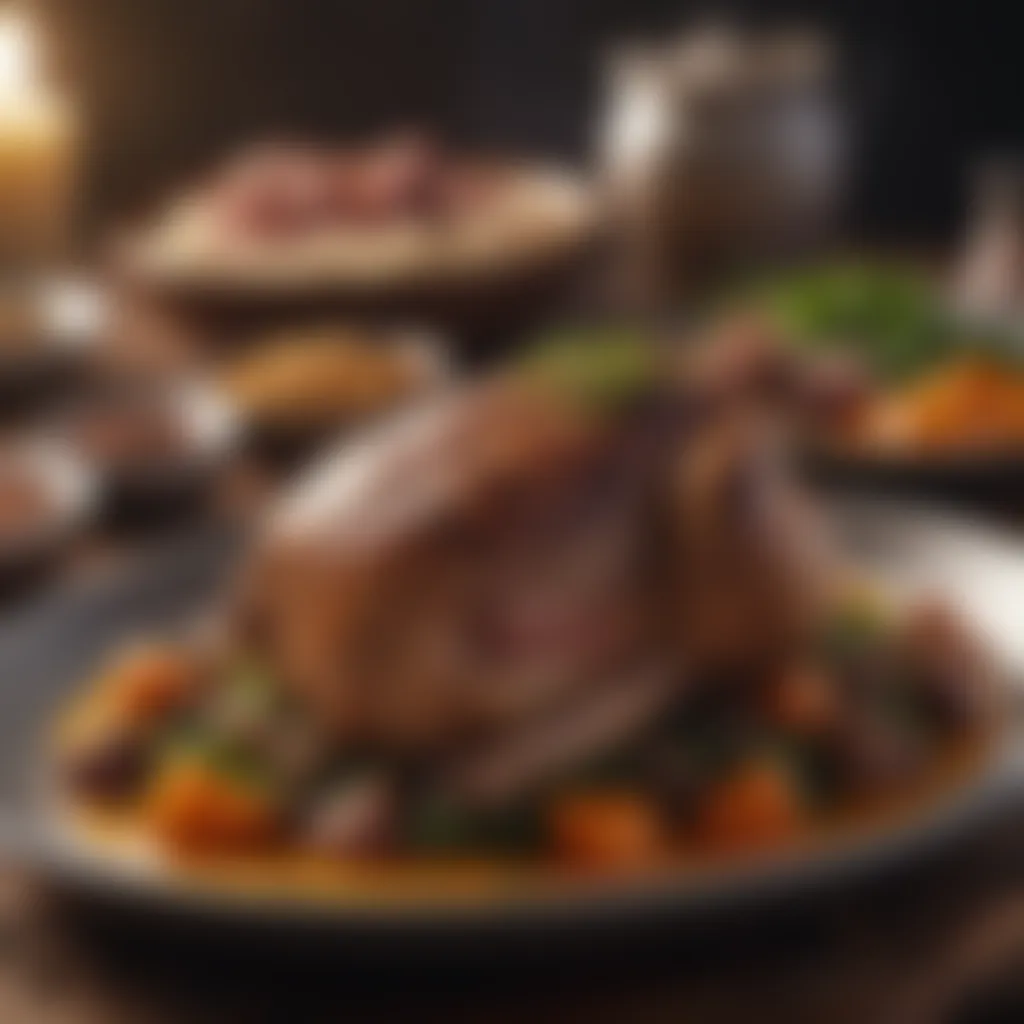
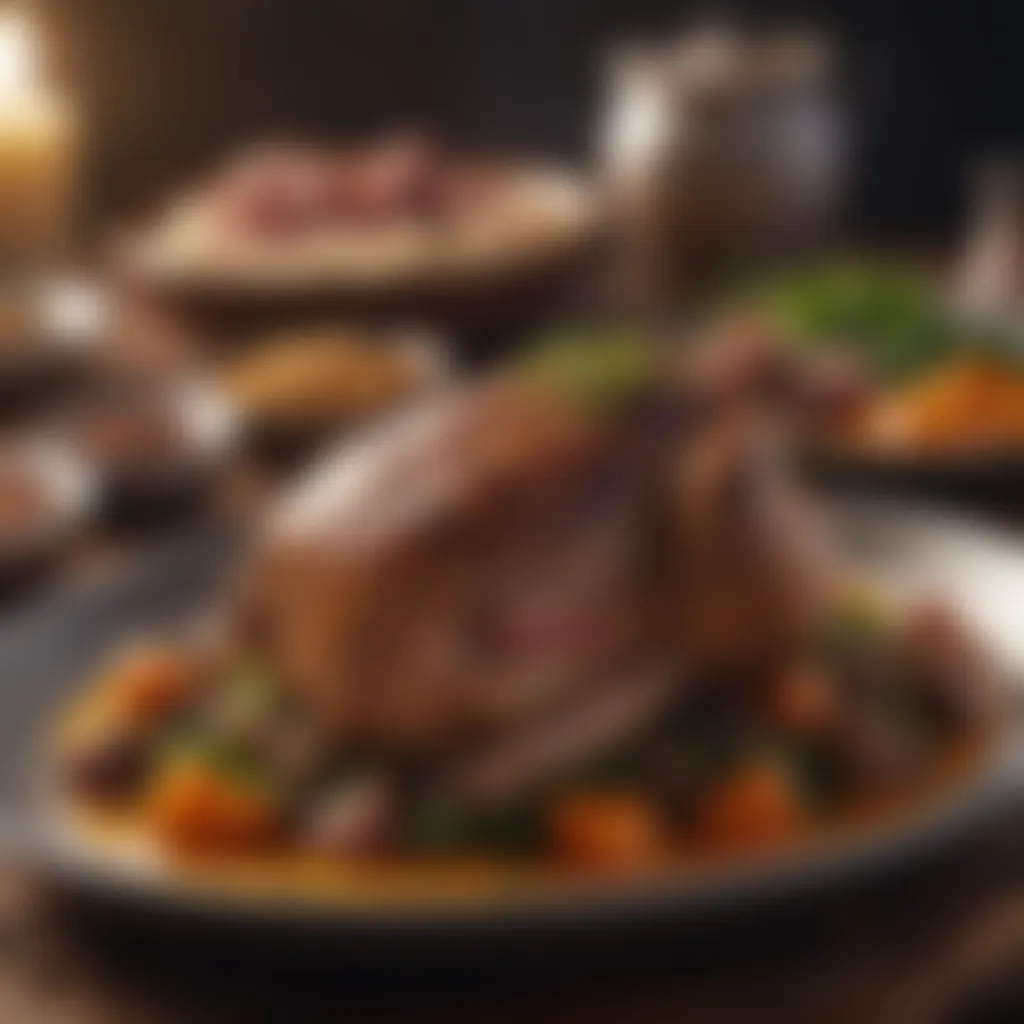
In the culinary world, every main dish, no matter how extraordinary, deserves the right companions to bring out its flavors. The same goes for lamb aqdah, a dish steeped in tradition and rich in taste. Selecting appropriate side dishes can enhance the meal's overall flavor profile and create a more satisfying dining experience.
Pairing sides isn't merely about filling the plate; it's about balance. Lamb aqdah, with its robust, hearty flavors, often benefits from lighter, fresher accompaniments that help to cut through its richness. This approach ensures that each bite of lamb is complemented rather than overshadowed.
Complementary Side Dishes
When considering sides for lamb aqdah, think variety and contrast. A few excellent options include:
- Couscous Salad: The fluffy texture of couscous, mixed with diced cucumbers, tomatoes, and a dash of lemon, provides a refreshing bite that pairs beautifully with lamb.
- Roasted Vegetables: Dark leafy greens like kale or spinach, alongside roasted carrots and zucchini, bring color to the plate and a slight earthy taste that balances the dish.
- Mint Yogurt Sauce: This tangy and cooling sauce is a classic that brings brightness to the heaviness of lamb, lifting the dish to new heights.
The idea here is to create a beautiful tapestry of flavors and textures on the plate. You've got the rich, savory lamb at the center, surrounded by these lighter sides that bring a little something extra.
Beverage Pairings
Beverage choices can elevate the dining experience just as much as the food. When enjoying lamb aqdah, the right drink can balance and enhance the flavors at play. Here are some thoughtful options:
- Red Wine: A full-bodied red, such as Cabernet Sauvignon or Shiraz, can match the intensity of the dish. These wines often have notes of dark fruit and spice, echoing the flavors within the lamb.
- Herbal Teas: Not feeling like wine? Herbal tea, especially mint or chamomile, can cleanse the palate without overwhelming the senses.
- Sparkling Water with Citrus: For a refreshing touch, sparkling water with a squeeze of lemon or lime adds effervescence that lightens the heaviness of the lamb.
Nutritional Considerations
When talking about lamb aqdah, it's crucial to examine its nutritional aspects as they play a significant role in the overall appreciation of the dish. While flavor undoubtedly steals the show, understanding the health contributions of lamb and how to accommodate dietary preferences can transform a simple meal into a wholesome feast.
Health Benefits of Lamb
Lamb is more than just a flavorful meat; it's a rich source of important nutrients that can be beneficial to health. Firstly, lamb provides high-quality protein, which is essential for muscle growth and repair. This protein is complete, meaning it contains all the amino acids our bodies need.
Moreover, lamb is packed with several vitamins and minerals. Vitamin B12 is particularly abundant, which is vital for the formation of red blood cells and proper nerve function. Additionally, lamb is an excellent source of iron, helping in the production of hemoglobin that carries oxygen in the blood. For those concerned about their heart health, lamb also contains conjugated linoleic acid (CLA), which has been linked to reduced body fat and improved cholesterol levels.
Incorporating lamb into a balanced diet can aid in maintaining energy levels and overall wellness. Yet, it's important to appreciate the quality of the meat as well—opting for grass-fed lamb can enhance the health benefits by providing more omega-3 fatty acids.
Balancing with Dietary Needs
Navigating dietary needs can be tricky, especially in a world where food allergies and preferences are so diverse. When serving lamb aqdah, it's important to find ways to cater to different diets.
For those with gluten sensitivities, adjusting the side dishes can make all the difference. Opting for new grains like quinoa or brown rice instead of traditional bread can still create a satisfying meal.
Individuals following a low-fat diet can enjoy lamb by trimming off excess fat before cooking or choosing lean cuts, such as leg or loin. On the flip side, those on a paleo or ketogenic diet may appreciate the healthy fats in lamb, as it aligns well with their dietary goals.
"Cooking is all about balance. Finding ways to incorporate different dishes can help ensure everyone's needs are met while enjoying the same feast together."
Finally, vegetarian or vegan guests can be included at the table by providing hearty vegetable dishes infused with spices that mirror the flavors of lamb aqdah. This gives everyone a chance to share in the culinary experience without feeling left out.
In essence, understanding the nutritional considerations of lamb aqdah enhances the cooking experience, allowing us to make conscious choices that cater to our body’s needs while honoring the cultural significance of this dish.
Closure and Reflection
In the culinary world, the crafting of a lamb aqdah recipe stands not only as a testament to skill but also as a celebration of culture and heritage. This section offers a moment of reflection on the various elements of lamb aqdah that we’ve explored and their significance in our broader appreciation for this delightful dish.
Summarizing Key Insights
Throughout this article, we’ve navigated the intricate path of creating a flavorful lamb aqdah. Each stage—from the thoughtful selection of lamb, spicing, and the marination process, to the cooking methods—plays a pivotal role in achieving the perfect harmony of flavors.
Here are some key takeaways:
- Quality of Ingredients: The foundation of any delicious lamb aqdah is the quality of lamb and other ingredients. Fresh and seasonal produce brings depth to the dish.
- Flavor Balance: The balance of spices forms a robust flavor profile; the right amount of cumin, coriander, and mint can elevate the dish.
- Cultural Significance: Understanding the cultural backdrop provides more appreciation for lamb aqdah. It reflects traditions passed down through generations, showcasing the values connected to family and community.
As we glean insights from preparation techniques and methods of presentation, it becomes clear that lamb aqdah is not just a dish, but a narrative of cultural exchange and creativity.
The Future of Lamb Aqdah
Looking ahead, the future of lamb aqdah appears promising, adapting to modern culinary trends while maintaining its traditional roots. As more people take a keen interest in cooking, experimental flavors and innovative techniques are likely to emerge.
- Fusion Recipes: Expect to see lamb aqdah paired with ingredients from different cuisines, transforming local traditions into globally appreciated dishes.
- Health Conscious Options: The rising focus on health will likely inspire variations revolving around leaner cuts of lamb or substitutions with other proteins
- Sustainable Practices: More chefs and home cooks are pay attention to sustainable meat sourcing, ensuring that our culinary practices align with ethical values.
Ultimately, the enduring allure of lamb aqdah will persist as a celebrated dish that encapsulates rich flavors, deep-rooted cultural significance, and a commitment to innovation.
In every bite of lamb aqdah, one can savor tradition, taste diversity, and experience culinary artistry at its finest.
As culinary enthusiasts, we must preserve the essence of lamb aqdah while embracing the exciting prospects that lie ahead. Through the unyielding evolution of this dish, we continue to strengthen our connection to our cultural heritage while paving the way for future generations to enjoy the artistry of creating lamb aqdah.
